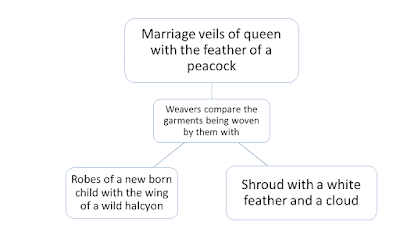Std 12 Englsih New Course
Paraphrase – Indian Weavers by Sarojini Naidu
Weavers are weaving a garment early in the morning. They are so happy. They are weaving the robes of a new born child. The robes are blue as the wings of a Kingfisher. In the evening weavers are weaving a bright garment. The garment is like the bright soft feathers of a peacock. It is the marriage veil of a queen. Weavers are solemn and still at the chill night. They are weaving the shroud for a dead man’s funeral. The garment is as white as feather and cloud.
Vocabulary
weavers – विणकर
Garment – वस्त्र
gay – आनंदी
robes- झगा
plumes – पंख
veil – ओढणी
solemn – गंभीर
shroud – प्रेतवस्त्र
funeral – अंत्यविधी संबंधी
Indian Weavers Paraphrase
विणकर सकाळी लवकर कपडे विणतात. ते खूप आनंदित आहेत. ते नवीन जन्मलेल्या मुलाचे वस्त्र विणतात. संध्याकाळी विणकर एक चमकदार पोशाख विणतात. वस्त्र मोराच्या चमकदार मऊ पंखांसारखे आहे. हे एका राणीच्या लग्नाचे बुरखे आहेत. विणकर गारठलेले आहेत. थंडगार रात्री आहेत. ते मृत माणसाच्या अंत्यसंस्कारासाठी कफन विणतात. वस्त्र पंख आणि ढगाप्रमाणे पांढरे आहे.
Read More:Song of the open road
Summary
“Indian Weavers” by Sarojini Naidu is a poem that celebrates the skill and artistry of Indian weavers. The poem vividly describes the scene of weavers at work, using their looms to create intricate patterns and designs on fabric. Naidu highlights the rhythmic motion of the looms and the hypnotic sound of the shuttles as they weave together threads of various colors. She praises the weavers for their patience, dedication, and craftsmanship, comparing them to artists who create beautiful tapestries out of the simplest of materials. The poem also touches upon the themes of tradition, heritage, and the timeless beauty of Indian craftsmanship. Overall, “Indian Weavers” pays homage to the talent and creativity of these unsung artisans, whose work enriches the cultural tapestry of India.
BRAINSTORMING On Indian Weavers
(A1) Discuss with your partner about the following vocations:
(a) Weaving – Weaving is a method of textile production in which two distinct sets of yarns or threads are interlaced at right angles to form a fabric or cloth.
(b) Tailoring – A tailoring is a profession in which a person makes, repairs, or alters clothing professionally, especially suits and men’s clothing.
(c) Knitting – Knitting is a method by which yarn is manipulated to create a textile or fabric; it is used in many types of garments
(d) Embroidering – Embroidering is to decorate cloth or clothing with patterns or pictures consisting of stitches that are sewn directly onto the material
(A2) (i) Discuss the various products made by the weavers in the poem.
Ans: In the poem the weavers made different garments for different people. The weavers wove the robes of a new-born baby, a marriage-veils of a queen and a dead man’s shroud.
(ii) The words in the three stanzas of the poem mention different times of a day. Complete the table.
| Time of the day | Words/phrases | Weaver’s work |
| Early morning | Break of day | Weavers weave robes for the new-bornchild |
| Late in the evening | Fall of night | They weave the marriage-veil of a queen. |
(iii) The poem reveals three phases of life. Fill in the blanks with feelings and colours appropriate to the phases of life. One is done for you.
| New-born/ Childhood | Youth/Adulthood | Old age/ Death | |
| Colour | Blue | Purple and green | White |
| Feeling | Hopes and expectations | Joy and delight | Sadness/ grief |
(iv) Complete: The weavers weave in the chill moonlight ………..(a dead man’s funeral shroud. )
(v) Pick out two words used to describe the weavers in the last stanza. Also state their importance.
The poet describes the weavers as solemn and still in the last stanza. They are solemn and still because they are weaving a shroud for the dead man.
(vi) Express your views about the present condition of weavers.
(vii) Describe in your own words the steps or measures that can be taken to
solve the problems of the weavers.
(viii) Express your own views and opinions from the weavers’ point of view and complete the following table.
| Stanza | Activity (done byweavers) | Views/Opinion |
| First stanza | Robes for a new-born child | The weavers feel gay because their work indicates the beginning full of hope. |
| Second stanza | Marriage-veil for a bride | They feel excited because their work indicates a new journey of life. |
| Third stanza | Shroud for a dead body | They are gloomy because their work indicates the end of life. |
(A3) (i) Pick out the rhyming words from the poem.
Day-gay ; wild-child ; night-bright; green-queen ; still-chill; cloud-shroud.
(ii) Give antonyms and synonyms of the following and make sentences of your
own.
| Word | Antonym | Synonym |
| new | old | latest |
| bright | dark | shining |
| dead | alive | expired |
| still | active | calm |
| wild | tame | fierce |
| fall | rise | Drop down |
| child | adult | Infant |
The figures of speech found in the poem “Weavers” by Sarojini Naidu:
1. Simile: Comparisons using “like” or “as.”
– “Blue as the wing of a halcyon wild”
– “Like the plumes of a peacock, purple and green”
-“White as a feather and white as a cloud”
2. Personification: Giving human characteristics to non-human entities.
–
3. Metaphor: Implied comparisons without using “like” or “as.”
–
4. Alliteration: Repetition of consonantal sound
– Why do you weave a garment so gay?
– Weavers, weaving solemn and still,
– Like the plumes of a peacock, purple and green,
These figures of speech enhance the poem’s imagery and contribute to its overall meaning and emotional impact.
Activity Set 1
Activities on Indian Weavers Std 12 English Poem
A1
| Time of the Day | Type of Garment | Colour of Garment | For Whom |
|---|---|---|---|
| Early in the Morning | ……….. | Blue | New Born Child |
| ………… | Marriage vels of Queen | Purple and Green | …….. |
| In the /dead Night | Dead Man’s Funeral Shroud | ………… | Dead Man |
Ans:
| Time of the Day | Type of Garment | Colour of Garment | For Whom |
|---|---|---|---|
| Early in the Morning | Robes of a new born Child | Blue | New Born Child |
| In the evening | Marriage veils of Queen | Purple and Green | Queen / Bride |
| In the dead Night | Dead Man’s Funeral Shroud | White | Dead Man |
A2. Complete the following web chart what weavers compare the garments being woven by them.
Ans:

A3. Describe in your words the steps or measures that you would take to solve the problems of weavers.
Ans: At the advent of textile industry weavers lost their work and wages. I would like to solve their problems by giving them suitable employment. I would appeal people to use handwoven clothes on certain occasions. I would like to help weavers with new technology and fashion. By adopting new measures they will compete with textile industry and get enough wages.
A4. The rhyme scheme of the first stanza is abab. Find rhyme scheme of in the second and the third stanza and also write down the rhyming pairs of words.
Ans: Rhyme Scheme Rhyming words
Second Stanza : ccdd night-bright, green-queen
Third Stanza : eeff still – chill; cloud – shroud
A5 Compose four lines on importance of clothes.
Ans: Importance of Clothes
One of the basic needs is clothes.
Clothes we wear with much cares
To protect our body from heat, cold And rain.
Some for status to hold.
Practice Set
Read the extract and do all the activities. For Practice on Indian Weavers
A1 Complete the table showing weavers’ routine.
| At break of day | —— | For new born child |
|---|---|---|
| ————– | Marriage veils. | ————— |
| ————— | shroud | For a dead man’s Funeral |
A2. Show the association between the three stages of day and life.
A3 State how parents feel at the time their daughter’s marriage.
A4. Point out the rhyming words and rhyme scheme of the poem.
A5. Create 4 poetic lines on weaving a uniform.
Answers :A1
| At break of day | Robes | For new born child |
|---|---|---|
| At fall of night | Marriage veils. | For a bride |
| In the moonlight chill | shroud | For a dead man’s Funeral |
A2. Three stages of the day represents the three stages of life. The morning represents thebeginning of life. The evening represents the adulthood. The chill moonlight night represents the end of life i.e. death.
A3. The parents have mix feeling at their daughter’s marriage ceremony. They are happy thattheir new life begins. They are sad because their daughter is parting with them.
À4 Rhyming words – day- gay wild- child night- bright green – queen still – chill cloud – shroudRhyme scheme : aabb
À5
Weavers, weaving at rising sun
Indian Weavers by Sarojini Naidu
Why do you weave a garment with fun?
With checks and colour mild
We weave the uniform for child.
Poetic Appreciation
Write a poetic appreciation of Indian Weavers with the help of the following points.
- · About the poem / poet and the title
- · The theme
- · Poetic Style
- · Language /Poetic devices
- · Special features
- · Message, values, morals in the poem
- · Your opinions about the poem
Sarojini Naidu is known as the Nightingale of India because of her poetry. ‘Indian Weavers’ is a short poem written by Sarojini Naidu. The poem depicts the three types of garment. The weavers weave at three particulars times of a day. The first stanza of the poem represents the birth, the second stanza represents youth and the last stanza death. These are the three important events in human life.
The poem is divided in three stanzas of 4 lines each. The first line rhymes with the second, and the third line with the fourth line in each stanza. The poem is in a sing song tone. The poem is in a question answer format.
The language of the poem is of everyday use. The poetess has used the colour imagery. The use of poetic devices like simile, and metaphor add pictorial effect. Alliteration, rhyming words and rhythm add musical effect.
The poem depicts three important stages of human life. Human being reacts differently at different stage. Metaphorically morning, noon and evening represents birth, child and death.
Click/ Touch here for The Inchcape Rock










[…] Indian Weavers Std 12 […]
Englishi
Fantastic !!
Superb! Sir, your channel ‘ Learn English Together’ is really helpful for teachers as well as students.
Very nice
Thank you.
Nice explained sir,
Such as vocabulary, summary, antonyms and synonym, figures of speech and Appreciation.
Thanks a lot of you.
Your efforts and dedication to the development of English are truly remarkable. You are a techno friendly teacher, and I like that very much. I believe it will be extremely helpful for all the students.